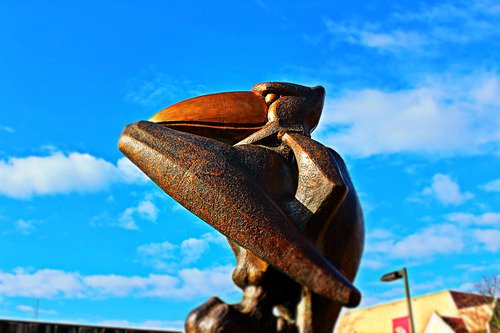“It takes a while”
In honor of Elden Tefft, the legendary sculptor and KU faculty member for decades who passed away this week, we’re looking at one of his most iconic - and earliest - works: the ‘Academic Jay.’
'Academic Jay’ appears to be so perfectly matched to the building it stands in front of that it’s easy to think that Strong Hall and the sculpture were always together. Or at least since the statue was created, 35 years after the building was finished. But it took even longer than that for the bronze Jayhawk to finally find its proper roost.
The statue was commissioned by the class of 1956 as their gift to the University, with an admonition to Tefft (according to an April 10, 1975 editorial in the Lawrence Journal World) by class president Allen Frame to “make it something of substance and class rather than just another cute statue for people to paint.” Tefft had only recently finished his graduate studies, but was already making a name for himself in the art world for championing the disappearing art of lost-wax casting for bronze sculpture. The ‘Academic Jay’ would be one of his earliest public displays of the technique.
Tefft completed the statue in time for graduation in 1959. The heavy bronze bird (published stories placed its weight anywhere from 600 to 1,000 pounds) was the “biggest single project handled in the KU Sculpture studio” at that time. The Journal-World editorial board was impressed and in a June 22, 1959 editorial titled “It Takes a While” tut-tutted those who had considered the statue a “highly impractical gift”, saying: “Add the … Jayhawk to the list of local items that were chuckled over, ridiculed, even guffawed at when they were proposed but which eventually won favor.”
It would spend nearly twenty years in a number of unremarkable locations in and around the Union before Chancellor Archie Dykes had it moved to its current prominent location in front of Strong Hall in 1975.
This may have been the result of the big bronze bird not being as universally beloved as the editorial writers had assumed it would become in its first few decades. According an August 17, 1978 article, students were not happy the statue had been moved to such a central location as it had been “dubbed a ‘Pterodactyl’ and students said they didn’t care where it was so long as it wasn’t so visible.” Hard to believe though, as the ‘Academic Jay’ has been a fixture for so many Jayhawkers’ photos over the years from their first campus visit to graduation day.
Despite its massive weight, the Jayhawk has ‘flown” once. On October 29, 1996, KU officials discovered ‘Academic Jay’ on the ground in front of its pedestal. Rusted out mounting equipment appeared to be the culprit, not vandalism (although the long-held campus lore regarding the graduation of a virgin was never officially ruled out). Dents to the crest and cracks to the neck and shoulder were repaired by Tefft and his son Kim before it was remounted on February 18, 1997.
TRIVIA BONUS
Basic trivia: Tefft created an identical bronze Jayhawk in 2006, which resides on the Edwards Campus in Overland Park
Bar Trivia: The class of 1956 gave $2,800 to commission the statue.
Showing Off Trivia: The bronze used for the statue is about a quarter inch-thick.
LFK Trivia: The first wearable Jayhawk mascot was made in 1950 of chicken wire and papier mache. When it wore out in 1958, Elden Tefft’s father, C.E. Tefft, fabricated a sturdier metal frame that was covered with canvas and would be used for several decades.





